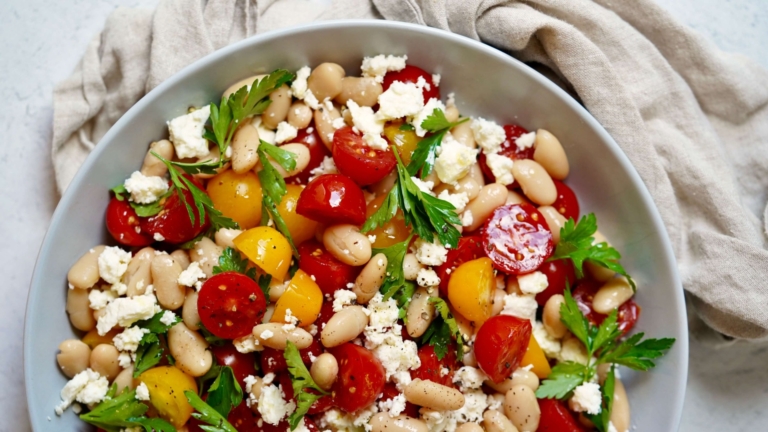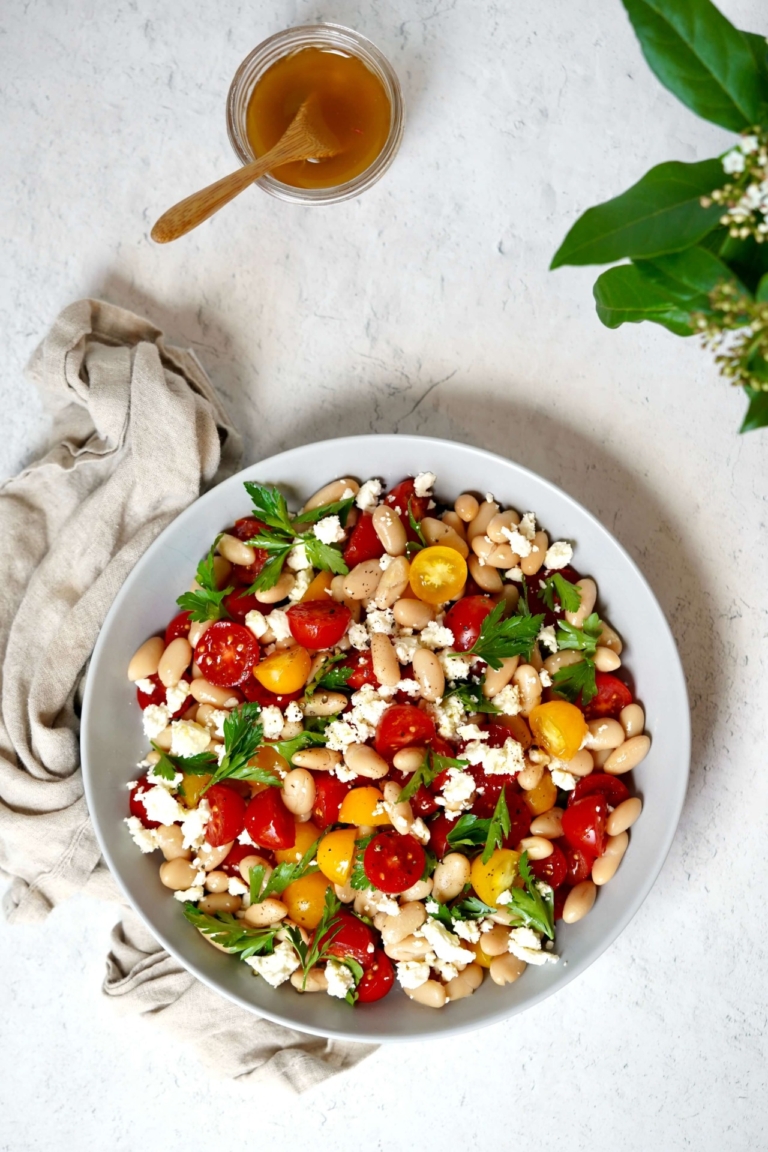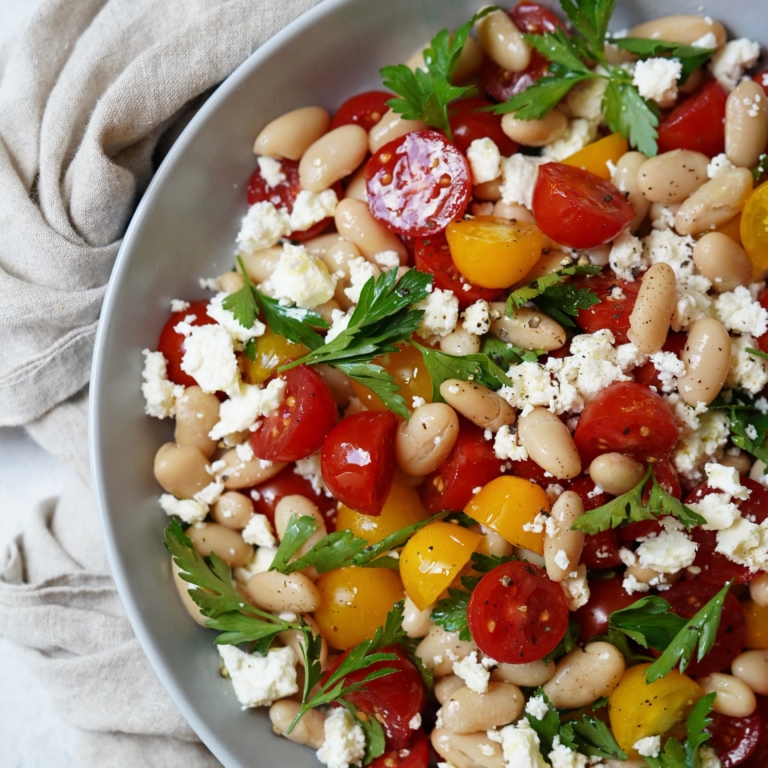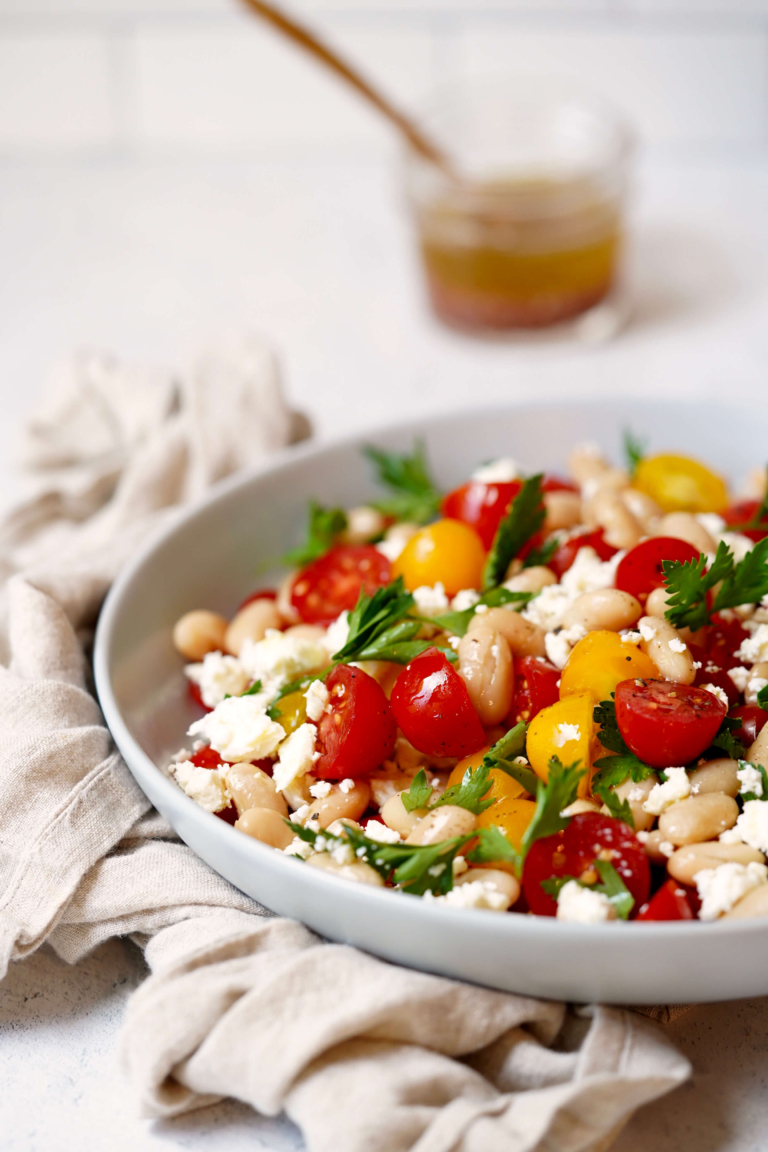Tomato, Bean And Feta Salad

I adore tomato salads of any kind and make them often when tomatoes are in season. If the tomatoes are farm fresh, the flavor is so intoxicating, that very little even needs to be added flavor-wise to make a great side dish to just about any entrée. But toss some beans in and you turn a simple vegetarian salad into a protein-packed dish that oozes healthy eating. This lovely tomato, bean, and feta salad has been on repeat in my house recently and it’s a keeper. This is not my recipe, it is from The Kitchn, I have only lightly adapted it, but the original can be seen here.
Beans
Beans are seeds from the Fabaceae family, more commonly known as the legume, pea, or bean family. They are an affordable source of protein, fiber, iron, and vitamins that offer many health benefits almost too long to list.
Many beans grow in pods or capsules that develop from flowers. Other legumes include peas, peanuts, and lentils. These beans are available dry, canned, or frozen. All of these beans differ nutritionally from green beans or wax beans where a person eats the entire pod. Beans contain amino acids, which are the protein building blocks that the body uses to heal and to make new tissues, such as bone, muscle, hair, skin, and blood.

Types of Beans
There are numerous types of beans. It is estimated that there are well over 400 different types or varieties of dry beans grown throughout the world. Most beans are consumed in local diets and don’t find their way onto our Western grocery shelves. Dried beans require a bit more effort and need cooking to make them tender enough to eat but they are worth the effort. Canned and frozen beans are typically ready to eat after warming on the stove or in the microwave making them a great easy option. Some of the most popular bean varieties include:
- lima beans
- black beans
- black-eyed peas
- soybeans
- kidney beans
- garbanzo beans
- navy beans
- pinto beans
- red beans
Protein Power
Protein is a vital nutrient that plays a key role in maintaining and repairing the body. Beans are high in amino acids, the building blocks of protein. There are sources and nine of these are essential. There are also two types of protein sources: incomplete and complete.
Animal products, soy, and quinoa are all complete proteins, which means they contain all nine essential amino acids. However, of all the types of beans, only soybeans contain all nine amino acids. People can combine incomplete proteins with nuts, seeds, dairy products, or grains at a single meal or throughout the day to make complete proteins. Beans make an excellent source of protein for vegetarians and vegans, but truthfully everyone should be eating beans in some capacity. Beans are also lower in calories and saturated fat than some other protein sources, such as meat and full-fat or low-fat dairy products.
Health Benefits of Beans
- Folate: Beans contain several vital nutrients, including folate. Folate is essential for overall health, to make healthy red blood cells.
- Antioxidants: Beans are rich in polyphenols, which are a type of antioxidant. Antioxidants fight off free radicals, which are damaging chemicals that the body produces during metabolism and other processes. Antioxidants help the body remove free radicals. In this way, antioxidant-rich foods, such as beans, can help protect the body from disease.
- Heart Health: It is believed people who consume beans regularly may be less likely to die of a heart attack or other cardiovascular problems. Research suggests that one reason for the decrease in cardiovascular risk was that people had replaced higher-fat animal meat proteins with beans.
- Reduced Risk of Cancer: Some studies have shown that beans act as antioxidants and anti-inflammatory agents. These effects could reduce the risk of cancer. Research published in 2015 analyzed whether beans might have antioxidant properties that fight intestinal cancer. The results suggested that black beans had the highest antioxidant activity.
- Diabetes and Glucose Metabolism: Some believe beans may also help stabilize blood glucose levels or even prevent diabetes. Beans are high in fiber, which can help lower blood glucose. Consuming a high-fiber diet may help reduce the risk of type 2 diabetes.
Two out of three in my family love beans of any kind, one is still what I call a work in progress. I’ll keep chipping away at him with recipes like this tomato and bean salad, and I think eventually I’ll penetrate that teenage fortress.

Tomato, Bean And Feta Salad
Ingredients:
For the Vinaigrette:
- 3 tablespoons Extra Virgin olive oil
- 1 1/2 tablespoons red wine vinegar
- 1 teaspoon shallot, minced
- Kosher salt, to taste
- Freshly ground black pepper, to taste
For the Salad:
- 1 (15-ounce) can white beans, drained and rinsed
- 2 cups red and/or yellow grape tomatoes, halved
- 3 ounces feta cheese, crumbled
- 1/2 cup fresh parsley leaves, whole or coarsely chopped
Directions:
- In a small bowl add the oil, vinegar, shallot, salt, and black pepper to taste, whisk well, and set aside.
- In a large serving bowl add the beans, tomatoes, feta, parsley, and toss to combine. Drizzle with the vinaigrette or serve on the side.




Leave a Reply